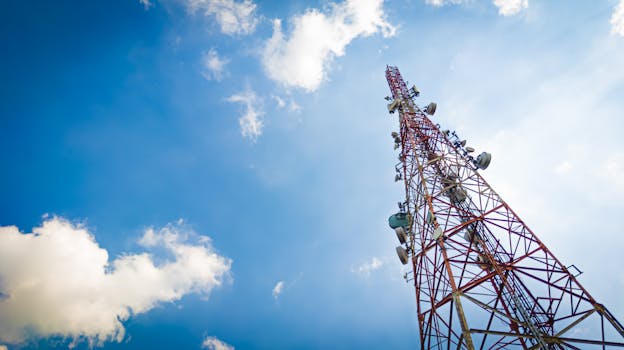LEO Satellites: Revolutionizing Global Connectivity with WordPress

LEO satellites are a type of satellite that orbits the Earth at a low altitude, typically between 160 and 2,000 kilometers. These satellites have gained popularity in recent years due to their ability to provide high-speed, low-latency internet connectivity to remote and underserved areas. With the help of WordPress, LEO satellites are revolutionizing the way we communicate and access information.
The use of LEO satellites has several advantages over traditional geostationary satellites. For one, they have a lower latency, which means that data can be transmitted and received much faster. This makes them ideal for applications that require real-time communication, such as video conferencing and online gaming. Additionally, LEO satellites have a higher bandwidth, which allows for faster data transfer rates.
WordPress, being one of the most popular content management systems, is playing a significant role in the development and deployment of LEO satellites. Many companies that provide LEO satellite services, such as SpaceX and Amazon, use WordPress to manage their websites and provide updates to their customers. WordPress also provides a range of plugins and themes that are specifically designed for the satellite industry, making it easier for companies to create and manage their online presence.
One of the most significant impacts of LEO satellites is their ability to provide internet connectivity to remote and underserved areas. Many parts of the world lack access to reliable and fast internet, which can hinder economic development and social progress. LEO satellites can help bridge this gap by providing high-speed internet connectivity to these areas, enabling people to access information, communicate with others, and participate in the global economy.
In addition to providing internet connectivity, LEO satellites are also being used for a range of other applications, including Earth observation, navigation, and communication. They can be used to monitor the environment, track weather patterns, and provide early warnings for natural disasters. They can also be used for navigation, providing location information and timing signals for a range of industries, including aviation, maritime, and transportation.
The use of LEO satellites is also driving innovation in the field of satellite technology. New technologies, such as advanced propulsion systems and compact antenna designs, are being developed to support the deployment of LEO satellites. Additionally, the use of artificial intelligence and machine learning is being explored to improve the efficiency and effectiveness of LEO satellite systems.
In conclusion, LEO satellites are transforming the way we communicate and access information, and WordPress is at the forefront of this revolution. With their high-speed, low-latency internet connectivity, LEO satellites are providing new opportunities for economic development, social progress, and innovation. As the use of LEO satellites continues to grow, we can expect to see even more exciting developments in the field of satellite technology.
The development of LEO satellites has also raised some concerns, such as the potential for space debris and the impact on the environment. However, many companies and organizations are working to address these concerns and ensure that the development and deployment of LEO satellites are done in a responsible and sustainable way.
Overall, the future of LEO satellites looks bright, with many exciting developments and innovations on the horizon. As we continue to explore the possibilities of LEO satellites, we can expect to see new and innovative applications for these satellites, from providing internet connectivity to remote areas to supporting the development of new technologies.
With the help of WordPress, the development and deployment of LEO satellites are becoming more efficient and effective. WordPress provides a range of tools and resources that can help companies and organizations to manage their online presence, provide updates to their customers, and promote their services. As the use of LEO satellites continues to grow, we can expect to see even more exciting developments in the field of satellite technology, and WordPress will be at the forefront of this revolution.
LEO satellites are not only transforming the way we communicate and access information, but they are also driving innovation in the field of satellite technology. New technologies, such as advanced propulsion systems and compact antenna designs, are being developed to support the deployment of LEO satellites. Additionally, the use of artificial intelligence and machine learning is being explored to improve the efficiency and effectiveness of LEO satellite systems.
The use of LEO satellites is also having a significant impact on the environment. They can be used to monitor the environment, track weather patterns, and provide early warnings for natural disasters. They can also be used to support the development of new technologies, such as renewable energy and sustainable agriculture.
In terms of the economic benefits, LEO satellites are providing new opportunities for economic development and growth. They can be used to provide internet connectivity to remote areas, enabling people to access information, communicate with others, and participate in the global economy. They can also be used to support the development of new industries, such as space tourism and satellite manufacturing.
However, the development and deployment of LEO satellites also raise some concerns, such as the potential for space debris and the impact on the environment. To address these concerns, many companies and organizations are working to develop sustainable and responsible practices for the deployment of LEO satellites.
One of the key challenges facing the development and deployment of LEO satellites is the need for sustainable and responsible practices. This includes ensuring that the satellites are designed and deployed in a way that minimizes the risk of space debris and environmental impact. It also includes ensuring that the satellites are used in a way that is fair and equitable, and that benefits are shared by all.
To address these challenges, many companies and organizations are working together to develop new technologies and practices for the deployment of LEO satellites. This includes the development of new propulsion systems, compact antenna designs, and other technologies that can help to reduce the environmental impact of LEO satellites.
In conclusion, LEO satellites are transforming the way we communicate and access information, and WordPress is at the forefront of this revolution. With their high-speed, low-latency internet connectivity, LEO satellites are providing new opportunities for economic development, social progress, and innovation. As the use of LEO satellites continues to grow, we can expect to see even more exciting developments in the field of satellite technology, and WordPress will be at the forefront of this revolution.
The future of LEO satellites looks bright, with many exciting developments and innovations on the horizon. As we continue to explore the possibilities of LEO satellites, we can expect to see new and innovative applications for these satellites, from providing internet connectivity to remote areas to supporting the development of new technologies.
With the help of WordPress, the development and deployment of LEO satellites are becoming more efficient and effective. WordPress provides a range of tools and resources that can help companies and organizations to manage their online presence, provide updates to their customers, and promote their services. As the use of LEO satellites continues to grow, we can expect to see even more exciting developments in the field of satellite technology, and WordPress will be at the forefront of this revolution.
History of LEO Satellites
LEO satellites have been in development for several decades, with the first LEO satellite being launched in the 1960s. However, it wasn’t until the 1990s that LEO satellites began to gain popularity, with the launch of the first commercial LEO satellite constellation.
Since then, the use of LEO satellites has continued to grow, with many companies and organizations launching their own LEO satellite constellations. Today, LEO satellites are used for a range of applications, including internet connectivity, Earth observation, navigation, and communication.
The development of LEO satellites has also driven innovation in the field of satellite technology. New technologies, such as advanced propulsion systems and compact antenna designs, are being developed to support the deployment of LEO satellites.
Additionally, the use of artificial intelligence and machine learning is being explored to improve the efficiency and effectiveness of LEO satellite systems. This includes using AI and ML to optimize satellite orbits, predict and prevent collisions, and improve communication protocols.
The use of LEO satellites is also driving innovation in the field of space law and policy. As the use of LEO satellites continues to grow, there is a need for clear and effective regulations to govern their use. This includes regulations related to the deployment of LEO satellites, their operation, and their eventual disposal.
Many countries and organizations are working together to develop these regulations, including the United Nations, the European Space Agency, and the Federal Communications Commission. These regulations will help to ensure that the development and deployment of LEO satellites are done in a responsible and sustainable way.
Applications of LEO Satellites
LEO satellites have a range of applications, including internet connectivity, Earth observation, navigation, and communication. They can be used to provide high-speed, low-latency internet connectivity to remote and underserved areas, enabling people to access information, communicate with others, and participate in the global economy.
LEO satellites can also be used for Earth observation, providing high-resolution images of the Earth’s surface. This can be used for a range of applications, including environmental monitoring, disaster response, and urban planning.
In addition, LEO satellites can be used for navigation, providing location information and timing signals for a range of industries, including aviation, maritime, and transportation. They can also be used for communication, providing a range of services, including voice, data, and video transmission.
The use of LEO satellites is also driving innovation in the field of satellite technology. New technologies, such as advanced propulsion systems and compact antenna designs, are being developed to support the deployment of LEO satellites.
Additionally, the use of artificial intelligence and machine learning is being explored to improve the efficiency and effectiveness of LEO satellite systems. This includes using AI and ML to optimize satellite orbits, predict and prevent collisions, and improve communication protocols.
The use of LEO satellites is also having a significant impact on the environment. They can be used to monitor the environment, track weather patterns, and provide early warnings for natural disasters. They can also be used to support the development of new technologies, such as renewable energy and sustainable agriculture.
In terms of the economic benefits, LEO satellites are providing new opportunities for economic development and growth. They can be used to provide internet connectivity to remote areas, enabling people to access information, communicate with others, and participate in the global economy.
They can also be used to support the development of new industries, such as space tourism and satellite manufacturing. Additionally, the use of LEO satellites is creating new job opportunities, both in the space industry and in other industries that rely on satellite technology.
Challenges and Limitations of LEO Satellites
While LEO satellites offer many benefits, they also pose some challenges and limitations. One of the key challenges is the need for sustainable and responsible practices for the deployment of LEO satellites. This includes ensuring that the satellites are designed and deployed in a way that minimizes the risk of space debris and environmental impact.
Another challenge is the need for clear and effective regulations to govern the use of LEO satellites. This includes regulations related to the deployment of LEO satellites, their operation, and their eventual disposal.
Additionally, there are also technical challenges associated with the deployment of LEO satellites. These include the need for advanced propulsion systems, compact antenna designs, and other technologies to support the deployment of LEO satellites.
There are also concerns about the impact of LEO satellites on the environment. The deployment of LEO satellites can result in space debris, which can pose a risk to other satellites and spacecraft. Additionally, the use of LEO satellites can also result in electromagnetic interference, which can impact the operation of other satellites and spacecraft.
To address these challenges, many companies and organizations are working together to develop new technologies and practices for the deployment of LEO satellites. This includes the development of new propulsion systems, compact antenna designs, and other technologies that can help to reduce the environmental impact of LEO satellites.
Additionally, there are also efforts underway to develop clear and effective regulations to govern the use of LEO satellites. This includes regulations related to the deployment of LEO satellites, their operation, and their eventual disposal.
Overall, while LEO satellites pose some challenges and limitations, they also offer many benefits and opportunities for economic development, social progress, and innovation. As the use of LEO satellites continues to grow, we can expect to see even more exciting developments in the field of satellite technology.
Conclusion
In conclusion, LEO satellites are transforming the way we communicate and access information, and WordPress is at the forefront of this revolution. With their high-speed, low-latency internet connectivity, LEO satellites are providing new opportunities for economic development, social progress, and innovation.
As the use of LEO satellites continues to grow, we can expect to see even more exciting developments in the field of satellite technology. The development of new technologies, such as advanced propulsion systems and compact antenna designs, will help to support the deployment of LEO satellites and improve their efficiency and effectiveness.
Additionally, the use of artificial intelligence and machine learning will continue to play a key role in the development and deployment of LEO satellites. This includes using AI and ML to optimize satellite orbits, predict and prevent collisions, and improve communication protocols.
The use of LEO satellites is also driving innovation in the field of space law and policy. As the use of LEO satellites continues to grow, there is a need for clear and effective regulations to govern their use. This includes regulations related to the deployment of LEO satellites, their operation, and their eventual disposal.
Many countries and organizations are working together to develop these regulations, including the United Nations, the European Space Agency, and the Federal Communications Commission. These regulations will help to ensure that the development and deployment of LEO satellites are done in a responsible and sustainable way.
Overall, the future of LEO satellites looks bright, with many exciting developments and innovations on the horizon. As we continue to explore the possibilities of LEO satellites, we can expect to see new and innovative applications for these satellites, from providing internet connectivity to remote areas to supporting the development of new technologies.



